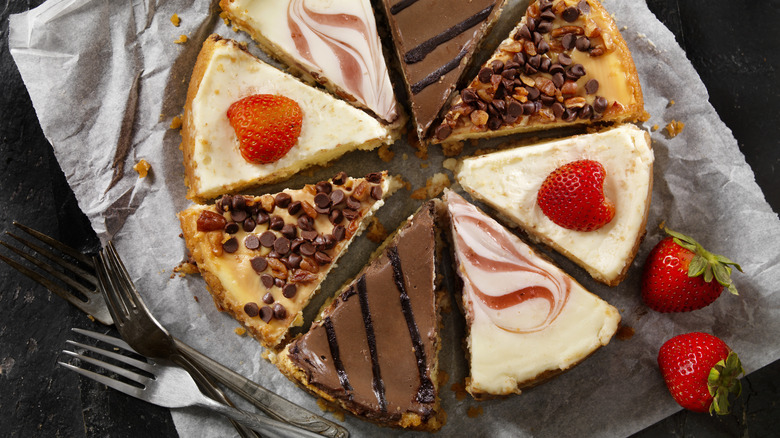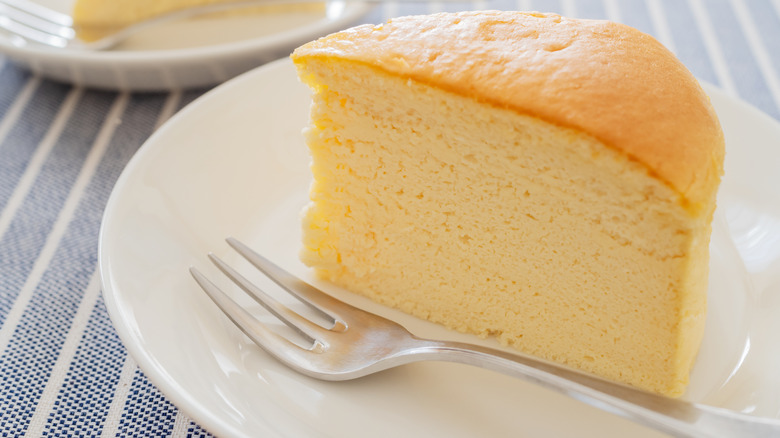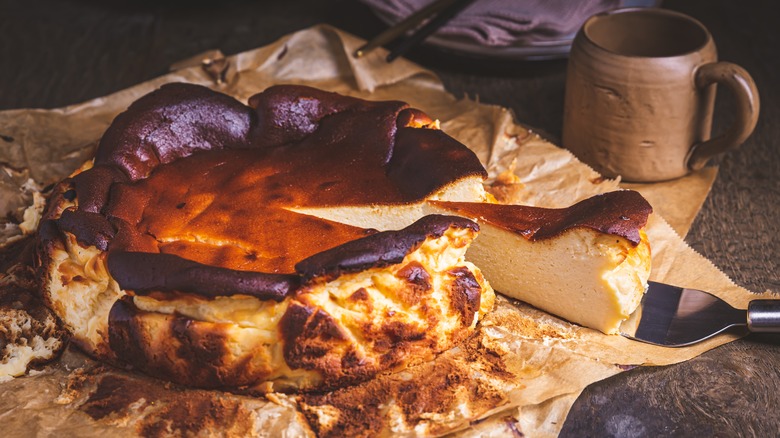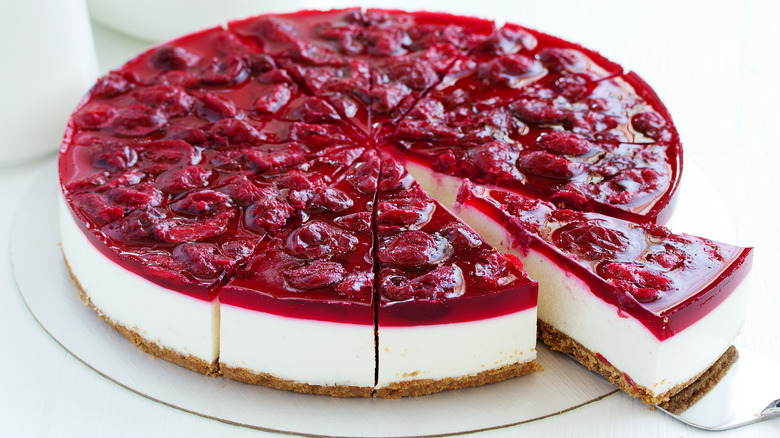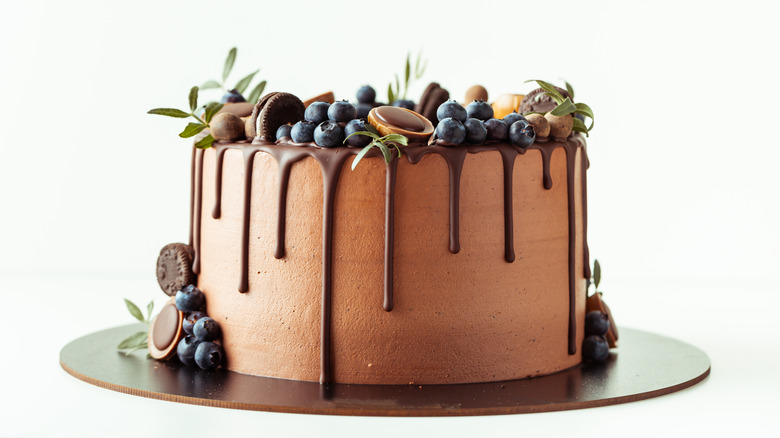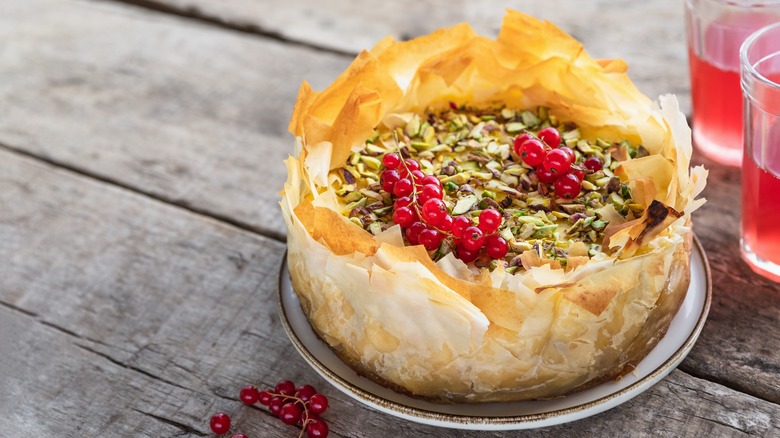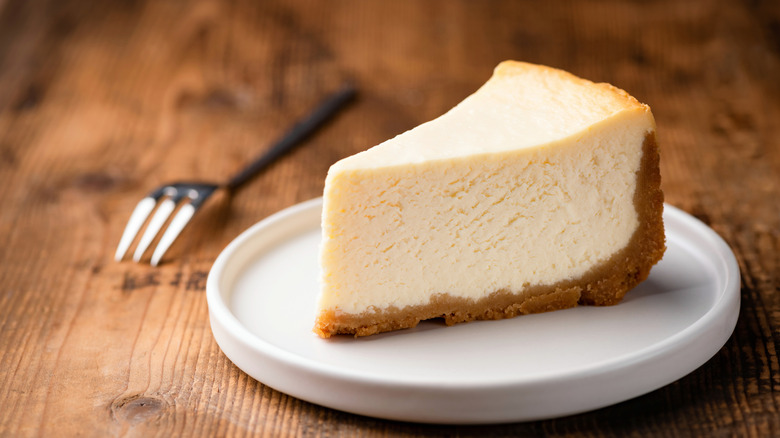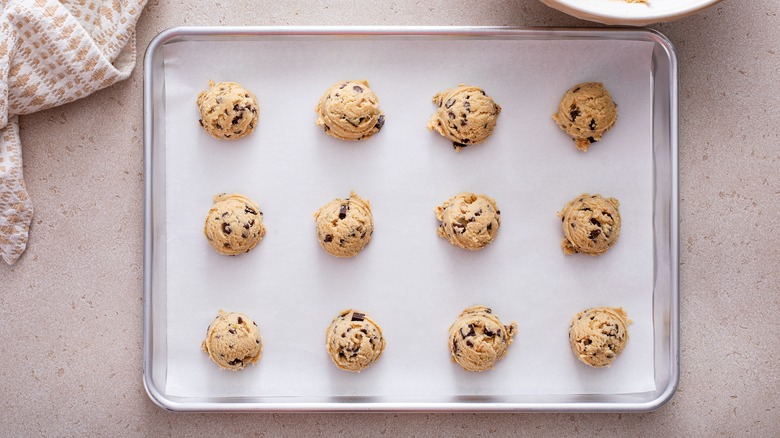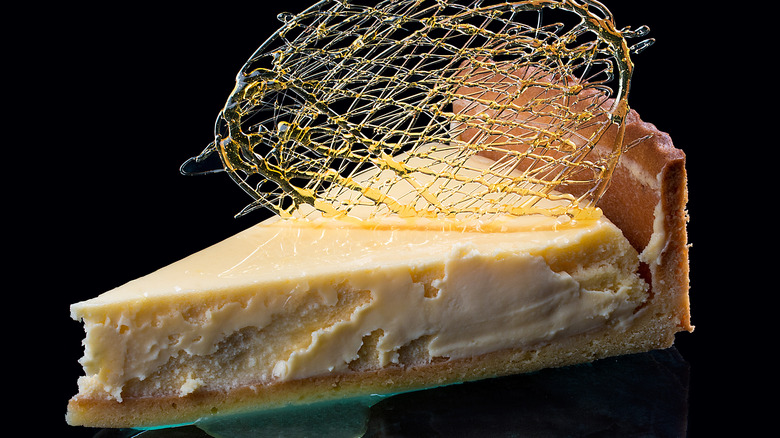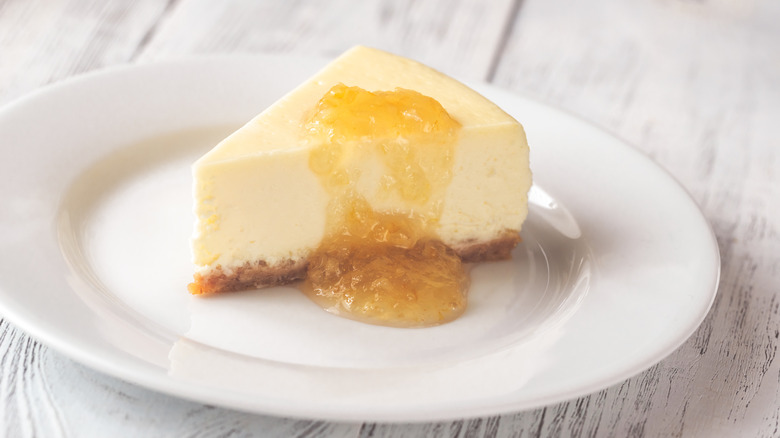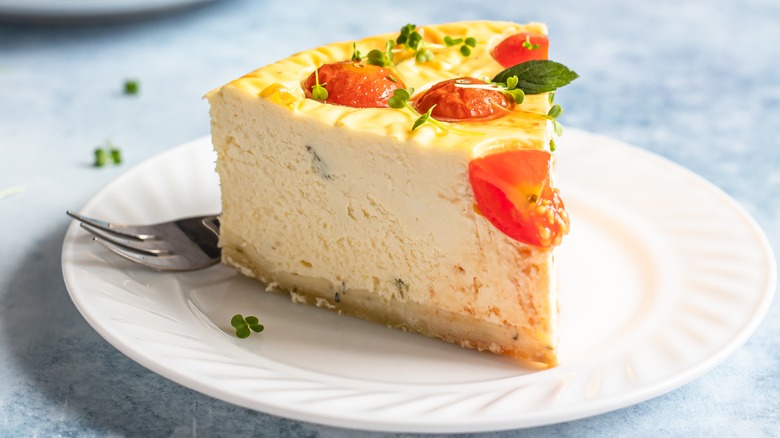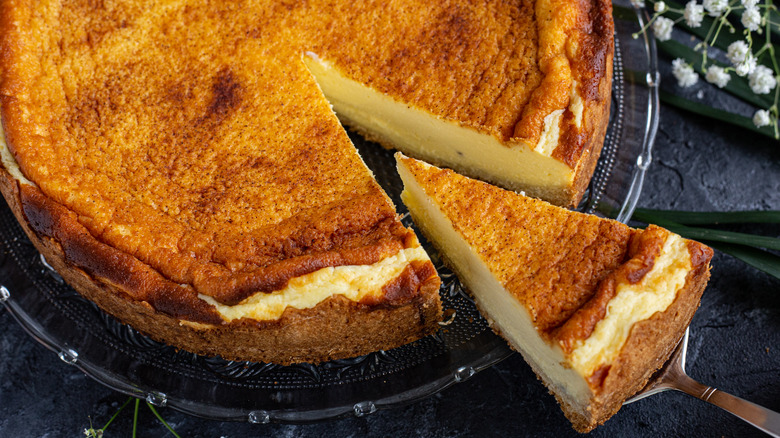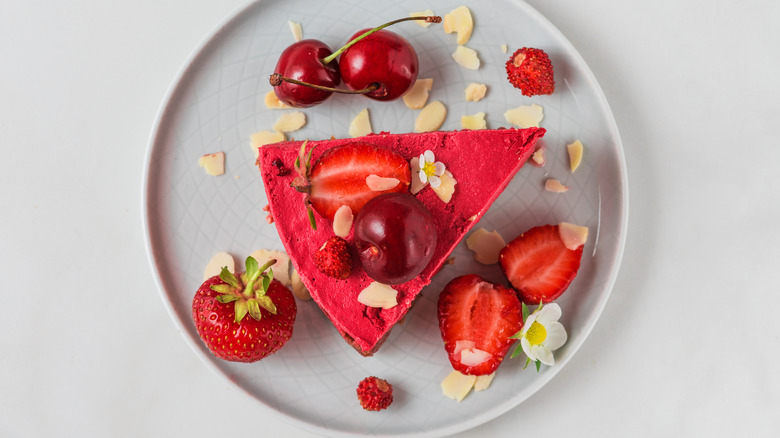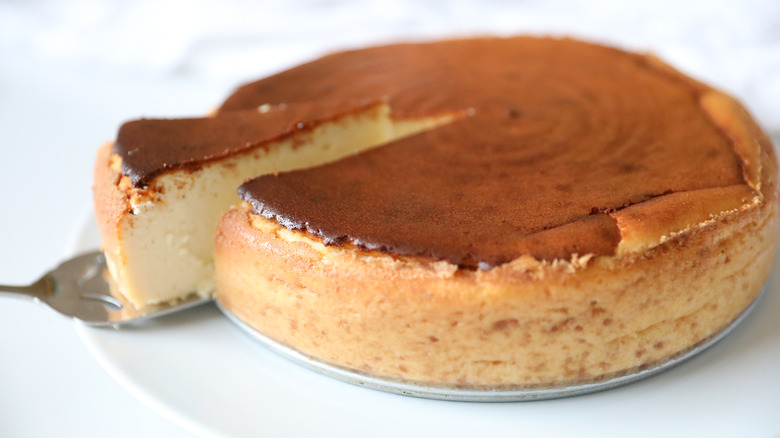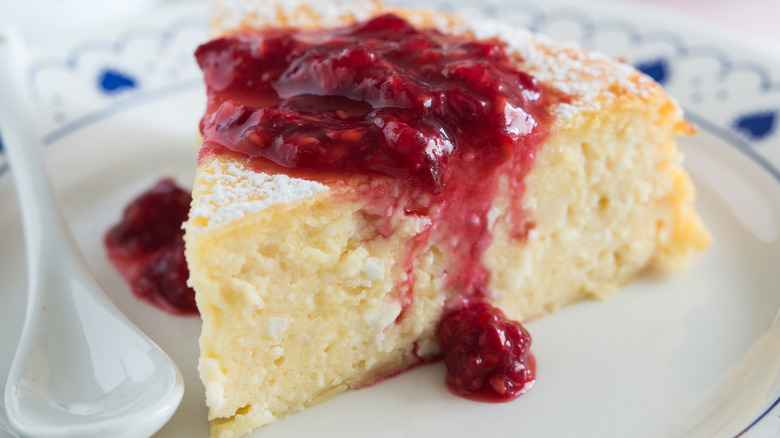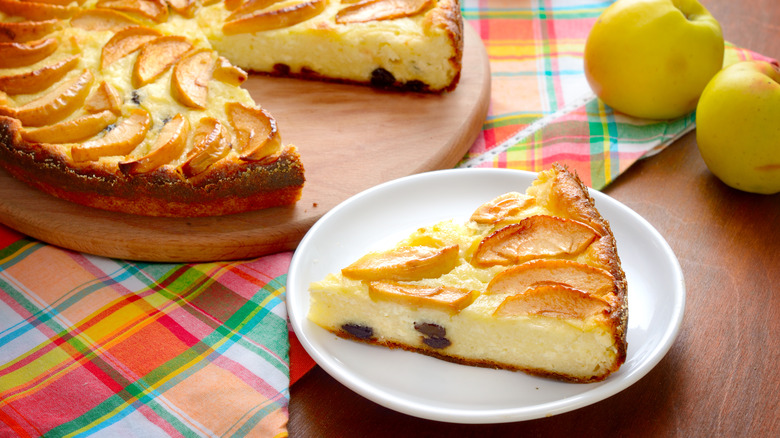The Ultimate Guide To Every Type Of Cheesecake
What is cheesecake? It isn't exactly a pie and it's definitely not a cake. Cheesecake is a favorite dessert baked worldwide and enjoyed by many cultures. Thought to have originated in Ancient Greece, cheesecake has a long storied history that dates back 4,000 years to the 5th century B.C. In its original form, cheesecake was made from fresh cheese patties mixed with flour and honey and then patted smooth. It was considered a good source of energy, eaten by Olympic athletes before competition, and also made regular appearances as a dessert at Ancient Greek weddings.
Cheesecake remained a staple in the Greek diet and in the late Middle Ages it resurfaced in England, but now with the addition of a pastry crust at the bottom formed in a tart pan. An early cheesecake recipe is even found in the first English cookbook written in 1390. From then on, cheesecake recipes were a staple in English cookbooks, cementing its place as a beloved dessert. Since the Middle Ages, the dessert has transformed tremendously into hundreds of different iterations, from the dense New York style to the fluffy Japanese version. Let's explore cheesecake's various forms in an exciting — and delicious — deep dive.
Japanese cheesecake
Japanese cheesecake is a jiggly dessert delicacy currently taking the social media world by storm. This trendy dessert is having a moment in the U.S. thanks to Japanese chains such as Uncle Tetsu breaking into the American market. Japanese cheesecake contains the creamy richness of American cheesecakes with the light airiness of a French souffle. That airiness, of course, also makes it a lot lighter and less cloyingly sweet than a typical American one.
The light spongelike consistency comes from a special technique of whisking egg whites and then delicately adding them into the batter by hand. This precise careful approach aerates the batter to maintain the airy quality of the finished product. While it takes plenty of time to achieve this texture, the finished product normally doesn't last too long — Japanese cheesecake is meant to be enjoyed fresh from the oven and piping hot. It comes in many different flavors such as strawberry, purple ube, and green matcha.
Basque cheesecake
Basque cheesecake gets its namesake from the coastal town of Donastia-San Sebastian in the Basque region of Spain. The birthplace of Basque cheesecake is La Vina, a small restaurant on the outskirts of town established in 1959. This dessert was discovered unexpectedly in 1990 by Spanish chef Santiago Rivera who was completing a bizarre quest to try and make a different type of cake every day. The outcome was the now global phenomenon known as Basque cheesecake.
This dessert is actually quite simple and only requires five ingredients: cream cheese, eggs, heavy cream, sugar, and a bit of flour. Resulting in an indulgently creamy and sweet take on cheesecake. The flan-like custard is baked at a very high heat that burns the outside forming a natural crust and leaves the inside soft and delicious. Those burnt spots and rough crustless appearance make it more rustic and break all the rules of a traditional American cheesecake. Traditionally served with nothing but a fork, Basque cheesecake is a delicious dessert without all the trappings and finery of other cheesecakes.
No-bake cheesecake
No-bake cheesecake is exactly what it sounds like — a cheesecake that isn't baked in an oven but is instead set in the fridge. It is traditionally made with just a handful of ingredients including: cream cheese, sweetened condensed milk, and lemon juice that are whipped together to make a smooth creamy filling. Unlike a traditional cheesecake, no-bake cheesecake doesn't include eggs which is why there is no need to bake it. The filling is poured over a graham cracker crust and left to firm up in the fridge for at least three hours or more. When making a no-bake cheesecake, be sure to account for the extended fridge time needed to ensure the dessert is thoroughly set up to avoid cutting into a runny pie.
To finish, the cheesecake can be topped with an array of fresh fruit, cherry pie filling, or even chocolate sauce. This quick and simple strawberry no-bake cheesecake is ideal for inexperienced bakers or those without access to an oven and produces a cool, creamy, refreshing summer dessert.
Cheesecake cake
Who says your dessert has to be only one type of cake? Have your cake and eat it too with a decadent layered cheesecake cake. This dessert combines the best of both worlds with layers of sponge cake and cheesecake united into one indulgent dessert. Start by making two layers of a light fluffy sponge cake of your choice from scratch or use a store-bought boxed cake mix to speed up the prep time. Next craft your classic cheesecake and bake as normal.
Once the cheesecake and spongecake have both cooled completely, it's time to assemble your dessert. Use cream cheese icing to sandwich the cheesecake between the two layers of spongecake to make a three-layered cake. Finish by covering the outside of the cake with frosting and refrigerate until serving. A cheesecake cake is versatile and can be made in multiple different flavors including chocolate and vanilla, cookies and cream, and chocolate peanut butter.
Baklava cheesecake
Discover a delightful Turkish take on classic cheesecake with baklava cheesecake. This cheesecake is made with fresh ricotta, honey, and plenty of sugar for a sweet creamy base. The crispy layered baklava base sets it apart from a traditional cheesecake base made of graham cracker crust. The star of the show is the baklava crust made from crushed pistachios, walnuts, olive oil, and phyllo dough. The ingredients are then layered on the bottom to form a crispy flaky crust. Assemble the base of this cheesecake by carefully layering phyllo dough and nuts, then brush with butter, and repeat for at least five rounds for an extra luxurious pastry crust.
Once the cheesecake is thoroughly baked it will be topped with homemade cinnamon sugar syrup to mimic the sugary sweetness of traditional baklava. The scratch-made syrup drips down into the crispy layers of baklava crust to create a rich and sticky dessert base. The cheesecake is then topped with pistachios and is ready to be enjoyed.
New York cheesecake
The New York cheesecake is one of the more famous chapters in cheesecake's long and storied history. In 1872, a New York dairy farmer named William A. Lawrence was trying to recreate the soft French cheese Nuefchatel, but he ended up inventing what is now known as Philadelphia cream cheese by accident. In the 1920s, a stabilizing ingredient was introduced to the cream cheese making it more spreadable and easier to bake with. By the 1930s, a Jewish immigrant and accomplished restauranteur by the name of Arnold Rueben concocted the original recipe for a traditional New York-style cheesecake using the newly developed cream cheese. Coincidentally, Mr. Reuben is most famous for his creation of the Reuben sandwich, but his innovative cheesecake dessert also quickly took the city by storm as rival delis sought to recreate Reuben's delectable dessert recipe.
New York cheesecake is known for its dense and creamy texture that is brought about by adding heavy cream to the cheesecake mixture. The addition of the heavy cream and a few extra eggs makes the dessert bigger and bolder. It is commonly cooked at a high temperature to achieve a golden brown crust on the top. It's best at a timeless New York restaurant or deli, but you can try your hand at making classic New York-style cheesecake at home, too.
Cheesecake cookies
Looking for a yummy cheesecake treat that combines the best flavors of cheesecake and cookies? Look no further, because cheesecake cookies have entered the chat. This obscure dessert only accounts for 7.6% of the way cheesecake is commonly used, per Tastewise, but it should be a staple in your baking rotation. Much quicker than making a full cheesecake, these cookies only need to bake for ten minutes and are an easy handheld alternative to a traditional cheesecake.
The cookies are made by first creating softened cream cheese balls sweetened with powdered sugar and frozen. Next whip up a classic cookie dough of any flavor you like such as sugar cookie dough or classic chocolate chip. After making the cookie dough use it to surround the frozen cream cheese balls and bake just until set, about 10 minutes. The secret to making the most delicious cheesecake cookies is to leave the cookies slightly underbaked. Promptly remove the cookies from the tray to prevent overbaking and enjoy.
Philadelphia cheesecake
When thinking of the origins of Philadelphia cheesecake, it is often assumed the name refers to the city of Philadelphia, but that assumption is incorrect. Despite popular belief, Philadelphia cheesecake doesn't get its namesake from The City of Brotherly Love. Instead, it takes its name from the brand Philadelphia cream cheese. This style of cheesecake originated as a genius marketing ploy by Philadelphia to sell more of its product. It comes as no surprise that this recipe uses more cream cheese than a New York-style cheesecake.
This version of cheesecake uses no heavy cream or sour cream — just extra cream cheese, which makes it lighter and fluffier in texture compared to a New York-style cheesecake. The Philadelphia cheesecake has become the default cheesecake in America and is what is most commonly made and thought of when one says cheesecake. Without any creamy fillers, Philadelphia cheesecake gets straight to the point offering a sweet and tangy dessert centered around the cheese for which it's named.
Chicago cheesecake
Just like New York and (less so) Philadelphia, Chicago is another major U.S. city with its own unique style of cheesecake. Unlike Chicago's famous deep-dish pizza, Chicago-style cheesecake is not as well-known outside of the region. Popularized by Eli's Cheesecake in Chicago, this dessert is a delicious regional staple worth exploring. This cheesecake originated after years of trial and error when restaurant owner Eli Schulman continuously tinkered with his recipe before perfecting the dessert.
Chicago-style cheesecake uses approximately eight extra ounces of cream cheese per recipe than a New York-style cheesecake. Using more cream cheese makes the cheesecake fluffier and lighter than its New York cousin, though it usually still calls for heavy cream or sour cream as a filler. Another big difference between New York and Chicago styles is the crust. While New York-style cheesecake is commonly made with a graham cracker crust, Chicago-style cheesecake is made using a buttery shortbread as the base.
Savory cheesecake
Ever wish you could have cheesecake for dinner? Savory cheesecakes are a dark horse in the cheesecake landscape that swaps sweet ingredients with savory ones for an interesting twist on the beloved dessert. Because cream cheese possesses a mild flavor and an indulgent creamy richness, the mix-in options for this appetizing snack are potentially limitless. Explore the wide array of flavor combinations such as spicy jalapeno popper, classic BLT, or muffuletta stuffed with cured meats and olives. Though they might be a bit harder to find, most savory cheesecakes have fewer eggs than a frittata, and unlike a quiche, the crust is optional. This dish makes an interesting appetizer for a dinner party or a conversation starter on a charcuterie board.
Using only cream cheese to make this treat isn't strictly necessary, and many recipes use feta, swiss, or even tangy blue cheese to elevate the flavors. To make a simple version of a savory cheesecake, start by patting down a crust of your choice — Parmesan cheese mixed with breadcrumbs works well- into the bottom of a springform pan. Next, sautee your savory add-ins on the stovetop until thoroughly cooked. Then, mix together all the filling, seasonings, and herbs before pouring on top of the crust, and bake for about 45 minutes. After baking and cooling, drizzle the savory cheesecake with a complementary flavor such as balsamic vinegar or a high-quality olive oil. Enjoy chilled with bruschetta, pretzels, or simply on its own.
German cheesecake
German cheesecake, traditionally known as kasecuchen, was popularized in Germany in the 1700s. Commonly made with quark and a base of shortcrust pastry, this dessert is a delightful summer treat. Quark is the main ingredient that sets this cheesecake apart from American cheesecakes that use cream cheese. It is a fresh dairy product made of milk that is common in Germany. The milk is soured by adding lactic acid bacteria to curdle the milk before it is then strained for the final product. The finished quark has a similar flavor profile and texture to cottage cheese, which makes for a creamy baked dessert. Because quark can be difficult to source in the United States and probably isn't in your local grocery store, many German cheesecake recipes now call for a mix of cottage cheese and Greek yogurt instead.
German cheesecake is lighter and fluffier than New York-style cheesecake and the crust is often made from a shortcrust dough or a yeast dough. This cake takes about an hour to bake and is traditionally enjoyed with a cup of black coffee in Germany.
Vegan cheesecake
Going vegan doesn't mean you have to give up this beloved dessert. There are many delicious dairy-free options to make a vegan cheesecake that might even be better than those you're used to. One straightforward option for making a dairy-free cheesecake is to simply swap the cream cheese out for dairy-free cream cheese, and skip the eggs. To thicken this version of a vegan cheesecake, a cornstarch slurry adds body to the dessert and doesn't add any flavor.
For a vegan alternative that's lower in fat, use sweetened and whipped tofu to fill the pie crust. Another option is to use blended cashews with coconut cream and sugar for an innovative protein-rich version of vegan cheesecake. Many vegan cheesecakes can be baked or no-bake, which makes them an easy and accessible way for those with dietary restrictions to enjoy a delicious treat. Just like non-vegan cheesecakes, though, the vegan versions are always better when topped with fresh, seasonal fruit.
Italian cheesecake
Although Greece is the birthplace of the original historic cheesecake, Romans are responsible for adding additional ingredients such as eggs and incorporating a pastry shell into their version of the dessert. Over time, this recipe spread throughout Europe and eventually to the Americas, with each region making their own tweaks to an ancient after-dinner treat.
Traditional Italian cheesecake is made with ricotta cheese instead of cream cheese. Ricotta is a silky Italian cheese that is commonly made from cows' milk, but can also be made from sheep, goat, or water buffalo milk. When translated into English, ricotta means "re-cooked," because it is made when fermented cheese is cooked at a high heat and then forms a very fine curd. When delicate cheese is used as the base ingredient, traditional Italian cheesecakes are notably creamier than some of the others on this list. Modern versions of Italian cheesecake are made without any crust and feature a brown caramelized cheese base instead. The light airiness of the ricotta pairs nicely with fresh fruit and is best served chilled.
Swedish cheesecake
The earliest existing records of Swedish cheesecake date back to 1538, when it was commonly seen as a status symbol among the medieval population. Developed in the Smaland region of Sweden, this dessert was commonly baked to celebrate momentous events such as Christmas and weddings.
This provincial cheesecake is quite different from traditional New York-style cheesecake because it uses rennet to convert milk into a type of homemade cottage cheese. Rennet is a complex set of digestive enzymes found in certain animal stomachs that make the cheese curdle. This method of curdling cheese is no longer common in the United States and can be bypassed by just using store-bought cottage cheese. Swedish cheesecake is made from fresh cottage cheese, bitter almonds, and eggs — and it doesn't have a crust. Once baked and set, this dessert is traditionally served chilled and topped with raspberry jam and whipped cream for a light and refreshing Swedish delicacy.
Russian cheesecake
In Russia, cheesecake is traditionally eaten as a breakfast food and is widely considered a healthy way to start your morning. This hearty breakfast cheesecake doesn't use cream cheese but instead uses Russian farmer's cheese known as tvorog. Russian farmer's cheese is a common dairy product in Eastern Europe and can best be described as a cross between cottage cheese and ricotta. It is made by fermenting milk and buttermilk for at least 24 hours to produce curds before cooking, much like ricotta. This cheese isn't common in the U.S. but it is simple to make your own at home.
To make this dessert — or, rather, breakfast — the farmer's cheese is combined with sugar, cream of wheat, eggs, raisins, and chopped apricots or orange peel. The mixture is poured into a round pan without a crust and baked for about an hour. The result is a sweet and satisfying breakfast cheesecake sure to make your morning a little brighter.
